
| Version | Summary | Created by | Modification | Content Size | Created at | Operation |
|---|---|---|---|---|---|---|
| 1 | Vivi Li | -- | 3513 | 2022-12-02 01:31:46 |
Video Upload Options
Eye color is a polygenic phenotypic character and is determined by the amount and type of pigments in the eye's iris. Humans and other animals have many phenotypic variations in eye color, as blue, brown, gray, green and others. These variations constitute phenotypic traits. The genetics of eye color are complicated, and color is determined by multiple genes. Some of the eye-color genes include EYCL1 (a green/blue eye-color gene located on chromosome 19), EYCL2 (a brown eye-color gene) and EYCL3 (a brown/blue eye-color gene located on chromosome 15). The once-held view that blue eye color is a simple recessive trait has been shown to be wrong. The genetics of eye color are so complex that almost any parent-child combination of eye colors can occur. In human eyes, these variations in color are attributed to varying ratios of eumelanin produced by melanocytes in the iris. The brightly colored eyes of many bird species are largely determined by other pigments, such as pteridines, purines, and carotenoids. Three main elements within the iris contribute to its color: the melanin content of the iris pigment epithelium, the melanin content within the iris stroma, and the cellular density of the iris stroma. In eyes of all colors, the iris pigment epithelium contains the black pigment, eumelanin. Color variations among different irides are typically attributed to the melanin content within the iris stroma. The density of cells within the stroma affects how much light is absorbed by the underlying pigment epithelium. OCA2 gene polymorphism, close to proximal 5′ regulatory region, explains most human eye-color variation.
1. Genetic Determination of Eye Color
Eye colors can range from the most common color, brown, to the least common, green. Eye color is an inherited trait influenced by more than one gene.[1][2] These genes are being sought using associations to small changes in the genes themselves and in neighboring genes. These changes are known as single nucleotide polymorphisms or SNPs. The actual number of genes that contribute to eye color is currently unknown, but there are a few likely candidates. A study in Rotterdam (2009) found that it was possible to predict the color of eyes with more than 90% accuracy for brown and blue, using just six SNPs (from six genes). [3]
The gene OCA2 (OMIM: 203200), when in a variant form, causes the pink eye color and hypopigmentation common in human albinism. (The name of the gene is derived from the disorder it causes, oculocutaneous albinism type II.) Different SNPs within OCA2 are strongly associated with blue and green eyes as well as variations in freckling, mole counts, hair and skin tone. The polymorphisms may be in an OCA2 regulatory sequence, where they may influence the expression of the gene product, which in turn affects pigmentation.[4] A specific mutation within the HERC2 gene, a gene that regulates OCA2 expression, is partly responsible for blue eyes.[5] Other genes implicated in eye color variation are: SLC24A4 [6] and TYR.[6]
Blue eyes with a brown spot, green eyes and gray eyes are caused by an entirely different part of the genome. As Eiberg said: "The SNP rs12913832 [of the Herc2 gene] is found to be associated with the brown and blue eye color, but this single DNA variation cannot explain all the brown eye color variation from dark brown over hazel to blue eyes with brown spots."
2. Classification of Color
Iris color can provide a large amount of information about an individual, and a classification of various colors may be useful in documenting pathological changes or determining how a person may respond to various ocular pharmaceuticals.[7] Various classification systems have ranged from a basic light or dark description to detailed gradings employing photographic standards for comparison.[7] Others have attempted to set objective standards of color comparison.[8]
As the perception of color depends on viewing conditions (e.g., the amount and kind of illumination, as well as the hue of the surrounding environment), so does the perception of eye color.[9]
Eye colors range from the darkest shades of brown to the lightest tints of blue.[1] To meet the need for standardized classification, at once simple yet detailed enough for research purposes, Seddon et al. developed a graded system based on the predominant iris color and the amount of brown or yellow pigment present.[10] There are three pigment colors that determine, depending on their proportion, the outward appearance of the iris: brown, yellow, and blue. Green irides, for example, have blue and some yellow. Brown irides contain mostly brown. Eye color in animals other than Homo sapiens are differently regulated. For example, instead of blue as in humans, autosomal recessive eye color in the skink species: Corucia zebrata is black, and the autosomal dominant color is yellow-green.[11]
3. Changes in Eye Color Throughout Life
In all populations, children are most commonly born with unpigmented eyes. As the child develops, melanocytes (cells found within the iris of human eyes, as well as skin and hair follicles) slowly begin to produce melanin. Because melanocyte cells continually produce pigment, eye color, in theory, can be changed. Most eye changes happen when the infant is around one year old, although it can happen up to three years of age.[12] Observing the iris of an infant from the side using only transmitted light with no reflection from the back of the iris, it is possible to detect the presence or absence of low levels of melanin. An iris that appears blue under this method of observation is more likely to remain blue as the infant ages. An iris that appears golden contains some melanin even at this early age and is likely to turn green or brown as the infant ages.
Changes (lightening or darkening) of eye colors during puberty, early childhood, pregnancy, and sometimes after serious trauma (like heterochromia) do represent cause for plausible argument to state that some eyes can or do change, based on chemical reactions and hormonal changes within the body.
Studies on Caucasian twins, both fraternal and identical, have shown that eye color over time can be subject to change, and major demelanization of the iris may also be genetically determined. Most eye-color changes have been observed or reported in the Caucasian population with hazel eyes.[13]
4. Eye Color Chart (Martin-Schultz Scale)
Carleton Coon created this chart by the Martin-Schultz scale often used in physical anthropology.
- Light eyes Eyes light and light mixed are 16-12 in Martin scale.
- Light
- Gray, blue, green.
- Light-mixed
- Very light-mixed (blue with gray or green, or green with gray)
- Light-mixed (light or very light-mixed with small admixture of brown pigment)
- Mixed eyes
- Mixed
- 12-6 in Martin scale. Mixture of light eyes (blue, gray or green) with brown pigment when light and brown pigment are the same level.
- Dark eyes
- Dark-mixed
- 6-4 in Martin scale. Brown with small admixture of light pigment.
- Dark
- 4-1 in Martin scale. Brown (light brown and dark brown) and very dark brown (almost black).
4.1. Amber
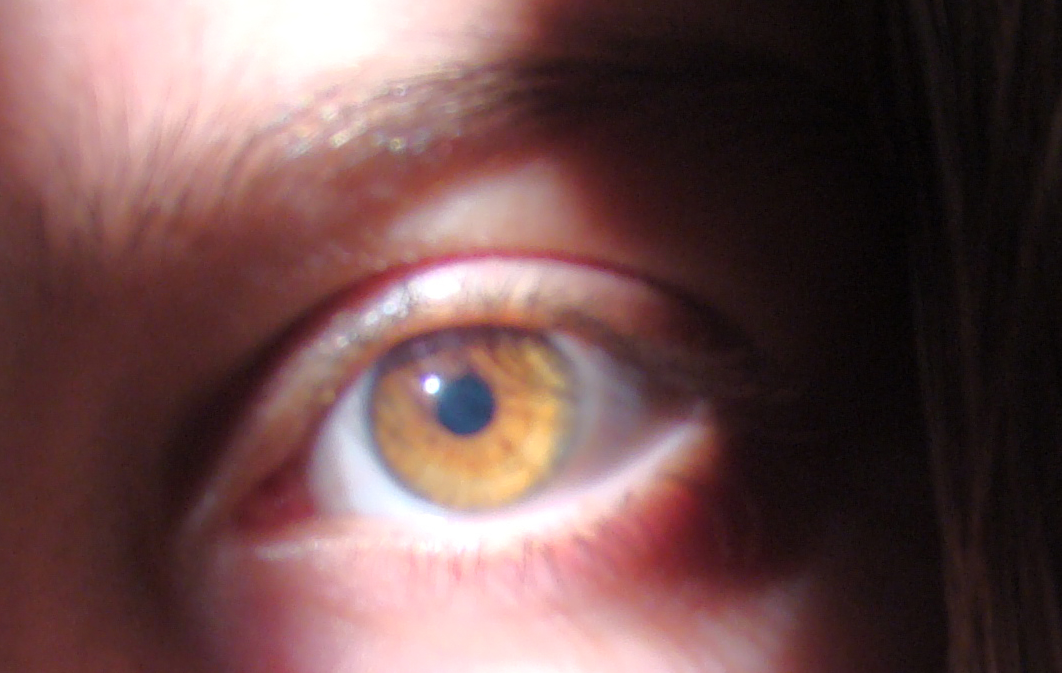
Amber eyes are of a solid color and have a strong yellowish/golden and russet/coppery tint. This might be due to the deposition of the yellow pigment called lipochrome in the iris (which is also found in green eyes).[14][15] Amber eyes should not be confused with hazel eyes; although hazel eyes may contain specks of amber or gold, they usually tend to comprise many other colors, including green, brown and orange. Also, hazel eyes may appear to shift in color and consist of flecks and ripples, while amber eyes are of a solid gold hue. Even though amber is considered to be like gold, some people have russet or copper colored amber eyes which many people mistake for hazel, though hazel tends to be duller and contains green with red/gold flecks, like mentioned above. Amber eyes may also contain amounts of very light gold-ish gray, found in animals like wolves.
The eyes of some pigeons contain yellow fluorescing pigments known as pteridines.[16] The bright yellow eyes of the Great Horned Owl are thought to be due to the presence of the pteridine pigment xanthopterin within certain chromatophores (called xanthophores) located in the iris stroma.[17] In humans, yellowish specks or patches are thought to be due to the pigment lipofuscin, also known as lipochrome.[18] Many animals such as canines, domestic cats, owls, eagles, pigeons and fish have amber eyes as a common color, whereas in humans this color occurs less frequently, more in places like Brazil and Asia.
4.2. Blue
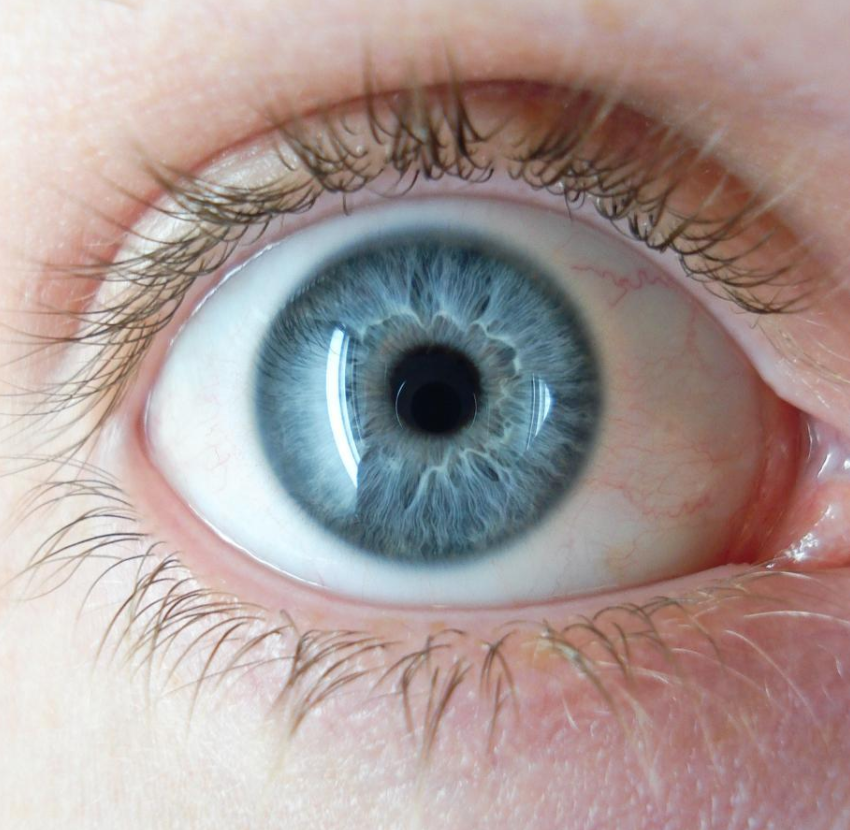
Blue eyes contain low amounts of melanin within the iris stroma; longer wavelengths of light tend to be absorbed by the underlying iris pigment epithelium, and shorter wavelengths are reflected and undergo Rayleigh scattering.[19] The type of melanin present is eumelanin.[20] The inheritance pattern followed by blue eyes is considered similar to that of a recessive trait (in general, eye color inheritance is considered a polygenic trait, meaning that it is controlled by the interactions of several genes, not just one).[2] In 2008, new research revealed that people with blue eyes have a single common ancestor. Scientists tracked down a genetic mutation that leads to blue eyes. "Originally, we all had brown eyes," said Hans Eiberg from the Department of Cellular and Molecular Medicine at the University of Copenhagen.[21] Eiberg and colleagues showed in a study published in Human Genetics that a mutation in the 86th intron of the HERC2 gene, which is hypothesized to interact with the OCA2 gene promoter, reduced expression of OCA2 with subsequent reduction in melanin production.[22] The authors concluded that the mutation may have arisen in a single individual in the Near East or around the Black Sea region 6,000–10,000 years ago during the Neolithic revolution.[21][22][23] Eiberg stated, "A genetic mutation affecting the OCA2 gene in our chromosomes resulted in the creation of a 'switch,' which literally 'turned off' the ability to produce brown eyes."
The genetic switch is located in the gene adjacent to OCA2 and rather than completely turning off the gene, the switch limits its action, which reduces the production of melanin in the iris. In effect, the turned-down switch diluted brown eyes to blue. If the OCA2 gene had been completely shut down, our hair, eyes and skin would be melanin-less, a condition known as albinism.[21]

Blue eyes are most common in Northern Europe and Central Europe and to a lesser degree in Southern Europe (Spain and Portugal are best examples, where 1-49% of the people are blue-eyed, through migration of Northern European and Central European settlers) and southern Central Asia; Afghanistan and Pakistan are a notable example.[24] They are also found in parts of North Africa,[25] West Asia, and South Asia,[26] in particular the northern areas of India, largely Kashmir. Pakistan and Iran also have a considerable population of blue eyed people.
A 2002 study found that the prevalence of blue eye color among Caucasians in the United States to be 33.8 percent for those born from 1936 through 1951 compared with 57.4 percent for those born from 1899 through 1905.[2] Blue eyes have become increasingly rare among American children, with only one out of every six or 16.6%, which is 49.8 million out of 300 million (22.4% of white Americans) of the total United States population having blue eyes.[27][28] The plunge in the past few decades has taken place at a remarkable rate. A century ago, 80 percent of people married within their ethnic group. Blue eyes were routinely passed down, especially among people of Western and Northern European ancestry.[27][28][29]
The outer surface of the iris of a blue-eyed person is actually clear, lacking the outer layer of pigmentation that is found in brown eyes. Their color is caused by the inner layer of pigmentation and the semi-opaque fibrous tissues that lie between the two layers.[30]
4.3. Brown
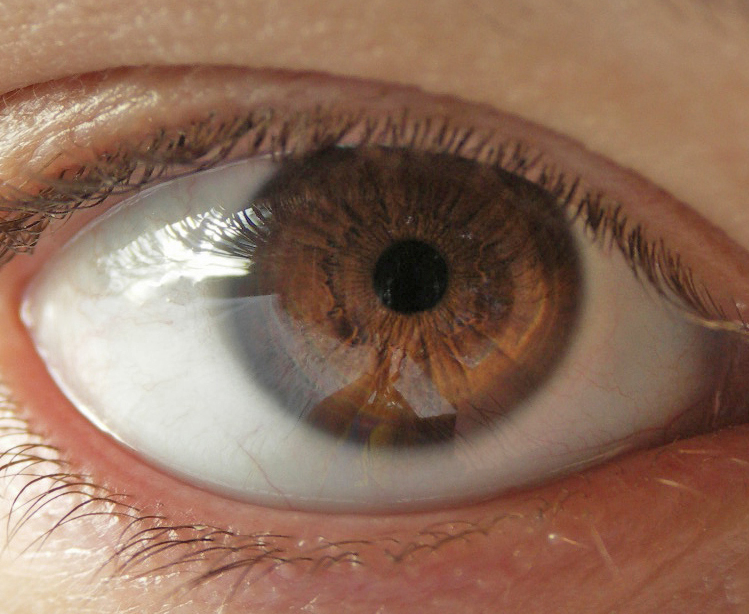
Brown eyes are dominant in humans[31] and in many parts of the world, it is nearly the only iris color present.[32] It is less common in countries around the Baltic Sea and in Scandinavia. Dark pigment of brown eyes are most common in East Asia, Southeast Asia, South Asia, West Asia, Oceania, Africa, and throughout the Americas. .
Light or medium-pigmented brown eyes are common in Europe, India, Iran, Armenia, Pakistan and Afghanistan, as well as and some parts of the Middle East. Light-pigmented brown eyes are sometimes referred to as "honey eyes".
In humans, brown eyes contain large amounts of melanin within the iris stroma, which serves to absorb light at both shorter and longer wavelengths. Brown eyes are the most common eye color, with over half of the world's population having them.
4.4. Gray
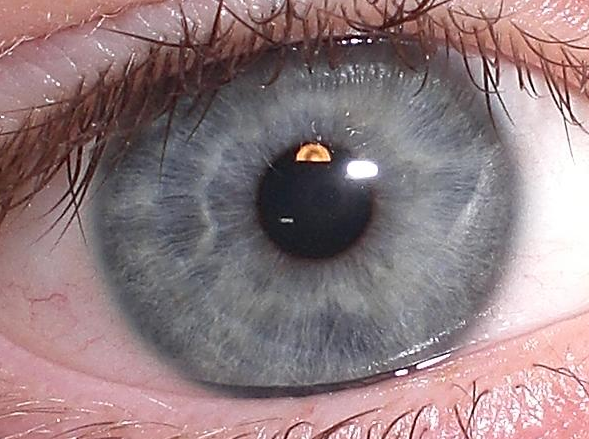
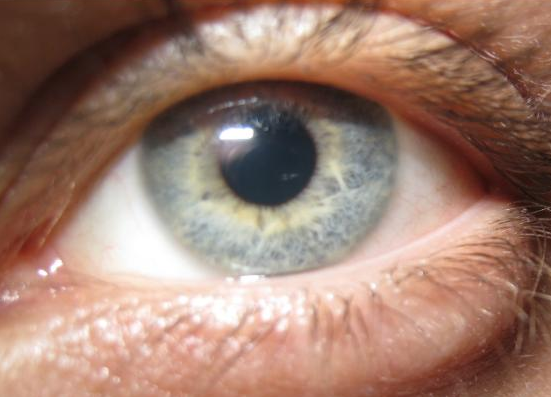
Gray eyes are most common in Northern and Eastern Europe. They can also be found, albeit rarely, in parts of Norway.[26] Gray eyes are also common among North Africans and South Indians. Under magnification, gray eyes exhibit small amounts of yellow and brown color in the iris. Ultimately, there are at least two things that could determine gray eye color. The first is the amount of melanin made, and the second is the density of the proteins in the stroma.[33]
A gray iris may indicate the presence of an uveitis. However, other visual signs make a uveitis obvious. Gray iris color, as well as blue, are at increased risk of uveal melanoma.[34]
4.5. Green
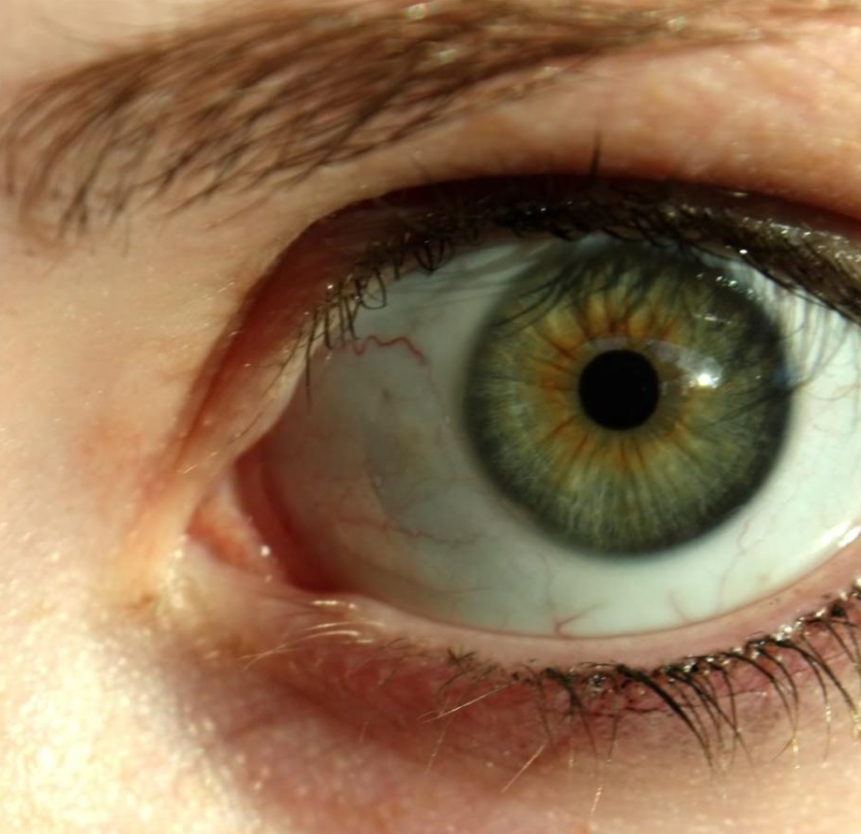
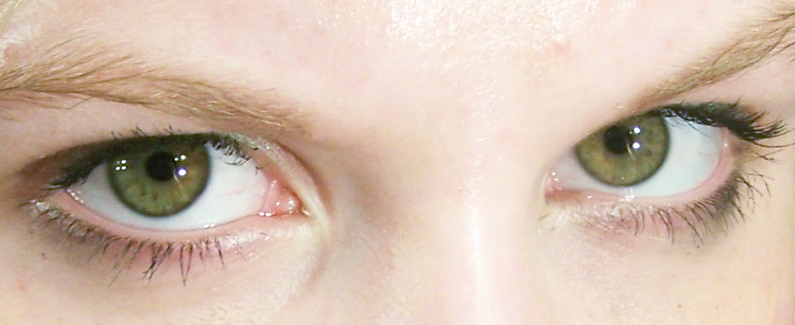
Green eyes are the product of low to moderate amounts of melanin and probably represent the interaction of multiple variants within the OCA2 and other genes. Green eyes are most common in Northern and Central Europe.[35][36] They can also be found in parts of Southern Europe[26] and North Africa. In Iceland, 89% of women and 87% of men have either blue or green eye color.[37] A study of Icelandic and Dutch adults found green eyes to be much more prevalent in women than in men. Among European Americans, green eyes are most common among those of Celtic and Germanic ancestry, about 16%.[38]
4.6. Hazel


Hazel eyes are due to a combination of Rayleigh scattering and a moderate amount of melanin in the iris's anterior border layer.[18][19] Hazel eyes often appear to shift in color from a light brown to a golden-green. Hazel mostly consists of brown and green. The dominant color in the eye can either be green or light brown/gold. This is how many people mistake hazel eyes to be amber and vice versa.[39][40][41][42][43][44][45] This can sometimes produce a multicolored iris, i.e., an eye that is light brown/amber near the pupil and charcoal or dark green on the outer part of the iris (and vice versa) when observed in sunlight. Hazel eyes are common in the following countries and regions such as Romania, Czech Republic, Austria, France, Spain, Bulgaria, Greece, Great Britain, Portugal, Chile, Italy, Hungary, Eastern Germany, Serbia, Croatia, Slovenia, United States, West Asia, Eastern Russia, Estonia, Mexico, Argentina, Brazil, Middle East, Colombia and Montenegro.
Definitions of the eye color hazel vary: it is sometimes considered to be synonymous with light brown or gold, as in the color of a hazelnut shell.[39][41][44][46]
4.7. Red

The eyes of people with severe forms of albinism may appear red under certain lighting conditions owing to the extremely low quantities of melanin,[47] allowing the blood vessels to show through. In addition, flash photography can sometimes cause a "red-eye effect", in which the very bright light from a flash reflects off the back of the eyeball, which is abundantly vascular, causing the pupil to appear red in the photograph.[48]
5. Medical Implications
Those with lighter iris color have been found to have a higher prevalence of age-related macular degeneration (ARMD) than those with darker iris color;[43] lighter eye color is also associated with an increased risk of ARMD progression.[49] An increased risk of uveal melanoma has been found in those with blue, green or gray iris color.[34][37] However, a study in 2000 suggests that people with dark brown eyes are at increased risk of developing cataracts and therefore should protect their eyes from direct exposure to sunlight.[50]
Eye color may also be symptomatic of disease. Aside from the iris, yellowing of the whites of the eyes is associated with jaundice and symptomatic of liver disease, including cirrhosis, hepatitis and malaria. Yellowing of the whites of the eyes in people with darker pigmented skin is often due to melanin being present in the whites of the eyes. However, any sudden changes in the color of the whites of the eyes should be addressed by a medical professional.
5.1. Wilson's Disease
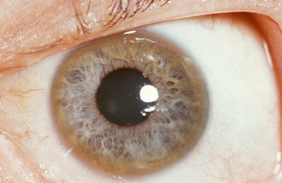
Wilson's disease involves a mutation of the gene coding for the enzyme ATPase7B, which prevents copper within the liver from entering the Golgi apparatus in cells. Instead, the copper accumulates in the liver and in other tissues, including the iris of the eye. This results in the formation of Kayser-Fleischer rings, which are dark rings that encircle the periphery of the iris.[51]
6. Anomalous Conditions
6.1. Aniridia
Aniridia is a congenital condition characterized by an extremely underdeveloped iris, which appears absent on superficial examination.[52]
6.2. Ocular Albinism and Eye Color
Normally, there is a thick layer of melanin on the back of the iris. Even people with the lightest blue eyes, with no melanin on the front of the iris at all, have dark brown coloration on the back of it, to prevent light from scattering around inside the eye. In those with milder forms of albinism, the color of the irides is typically blue but can vary from blue to brown. In severe forms of albinism, there is no pigment on the back of the iris, and light from inside the eye can pass through the iris to the front. In these cases, the only color seen is the red from the hemoglobin of the blood in the capillaries of the iris. Such albinos have pink eyes, as do albino rabbits, mice, or any other animal with a total lack of melanin. Transillumination defects can almost always be observed during an eye examination due to lack of iridial pigmentation.[53] The ocular albino also lacks normal amounts of melanin in the retina as well, which allows more light than normal to reflect off the retina and out of the eye. Because of this, the pupillary reflex is much brighter in the albino, and this can increase the red eye effect in photographs.
6.3.Heterochromia

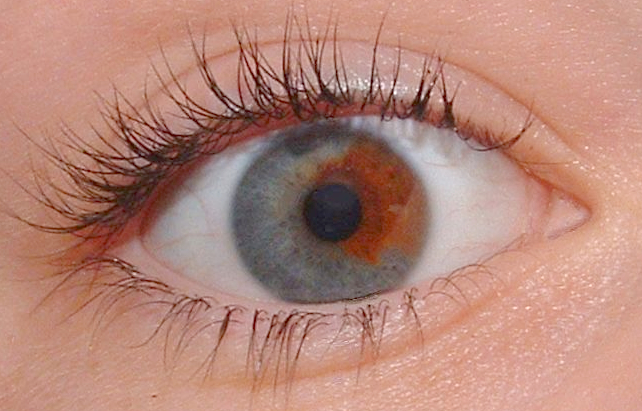
Heterochromia (also known as a heterochromia iridis or heterochromia iridium) is an ocular condition in which one iris is a different color from the other iris (complete heterochromia), or where the part of one iris is a different color from the remainder (partial heterochromia or sectoral heterochromia). It is a result of the relative excess or lack of pigment within an iris or part of an iris, which may be inherited or acquired by disease or injury.[54] This uncommon condition usually results due to uneven melanin content. A number of causes are responsible, including genetic, such as chimerism, Horners Syndrome and Waardenburg syndrome.
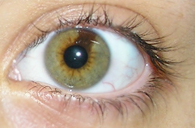
A chimera can have two different colored eyes just like any two siblings can—because each cell has different eye color genes. A mosaic can have two different colored eyes if the DNA difference happens to be in an eye color gene.
There are many other possible reasons for having two different colored eyes. For example, David Bowie has the appearance of different eye colors due to an injury that caused one pupil to be permanently dilated. Another idea about how this can happen is if an early viral infection while in the womb turns an eye color gene on or off in just one eye. Occasionally it can be a sign of a serious disease.
A common cause in females with heterochromia is X-inactivation, which can result in a number of heterochromatic traits, such as calico cats. Trauma and certain medications, such as some prostaglandin analogues, can also cause increased pigmentation in one eye.[55] On occasion, the condition of having two different-colored eyes is caused by blood staining the iris after sustaining injury.
References
- Sturm RA, Frudakis TN (August 2004). "Eye colour: portals into pigmentation genes and ancestry". Trends Genet. 20 (8): 327–32. doi:10.1016/j.tig.2004.06.010. PMID 15262401. http://www.biosci.ohio-state.edu/~pfuerst/courses/eeobmg640/reading1eyecolor.pdf.
- Grant MD, Lauderdale DS (2002). "Cohort effects in a genetically determined trait: eye colour among US whites". Ann. Hum. Biol. 29 (6): 657–66. doi:10.1080/03014460210157394. PMID 12573082. https://dx.doi.org/10.1080%2F03014460210157394
- "DNA test for eye colour could help fight crime", New Scientist 14 March 2009. Fan Liu, van Duijn K, Vingerling JR, et al. (10 March 2009). "Eye color and the prediction of complex phenotypes from genotypes". Current Biology 19 (5): R192–R193. doi:10.1016/j.cub.2009.01.027. PMID 19278628. http://www.sciencedirect.com/science?_ob=ArticleURL&_udi=B6VRT-4VT0BCK-B&_user=10&_rdoc=1&_fmt=&_orig=search&_sort=d&view=c&_acct=C000050221&_version=1&_urlVersion=0&_userid=10&md5=54b555b22ad247b14c52eefca5927645.
- Duffy DL, Montgomery GW, Chen W, et al. (February 2007). "A three-single-nucleotide polymorphism haplotype in intron 1 of OCA2 explains most human eye-color variation". Am. J. Hum. Genet. 80 (2): 241–52. doi:10.1086/510885. PMID 17236130. http://www.pubmedcentral.nih.gov/articlerender.fcgi?tool=pmcentrez&artid=1785344
- Kayser M, Liu F, Janssens AC, et al. (February 2008). "Three genome-wide association studies and a linkage analysis identify HERC2 as a human iris color gene". Am. J. Hum. Genet. 82 (2): 411–23. doi:10.1016/j.ajhg.2007.10.003. PMID 18252221. http://www.pubmedcentral.nih.gov/articlerender.fcgi?tool=pmcentrez&artid=2427174
- Sulem P, Gudbjartsson DF, Stacey SN, et al. (December 2007). "Genetic determinants of hair, eye and skin pigmentation in Europeans". Nat. Genet. 39 (12): 1443–52. doi:10.1038/ng.2007.13. PMID 17952075. https://dx.doi.org/10.1038%2Fng.2007.13
- German EJ, Hurst MA, Wood D, Gilchrist J (March 1998). "A novel system for the objective classification of iris colour and its correlation with response to 1% tropicamide". Ophthalmic Physiol Opt 18 (2): 103–10. doi:10.1016/S0275-5408(97)00070-7. PMID 9692029. http://www3.interscience.wiley.com/resolve/openurl?genre=article&sid=nlm:pubmed&issn=0275-5408&date=1998&volume=18&issue=2&spage=103.
- Fan S, Dyer CR, Hubbard L. Quantification and Correction of Iris Color." Technical report 1495, University of Wisconsin-Madison, Dec, 2003. http://www.cs.wisc.edu/~shaohua/research/iris/IrisColor_files/IrisTr1495.pdf
- Color Perception http://www.edromanguitars.com/tech/color.htm
- Seddon, J.M.; CR Sahagian, RJ Glynn, RD Sperduto and ES Gragoudas (1 August 1990). "Evaluation of an iris color classification system". Investigative Ophthalmology & Visual Science (Association for Research in Vision and Ophthalmology) 31 (8): 1592–8. PMID 2201662. http://www.iovs.org/cgi/content/abstract/31/8/1592. Retrieved 2009-05-04.
- Jones, S.L., Schnirel, B.L., Subspecies comparison of the Genus: Corucia, Leeway Corucia Research Center - LCRC, Polyphemos, Volume 4, Issue 1. pp. 1–25.
- Aluzri, Shan Z., All About Eyes., retrieved on june, 1, 2009. http://j-sallabouteyes.wetpaint.com
- Arch Ophthalmol http://archopht.ama-assn.org/cgi/content/abstract/115/5/659
- Howard Hughes Medical Institute: Ask A Scientist http://www.hhmi.org/cgi-bin/askascientist/highlight.pl?kw=&file=answers%2Fgenetics%2Fans_044.html
- Eye Color http://www.eyecarecontacts.com/eyecolor.html
- Oliphant LW (1987). "Observations on the pigmentation of the pigeon iris". Pigment Cell Res. 1 (3): 202–8. doi:10.1111/j.1600-0749.1987.tb00414.x. PMID 3508278. https://dx.doi.org/10.1111%2Fj.1600-0749.1987.tb00414.x
- Oliphant LW (1981). "Crystalline pteridines in the stromal pigment cells of the iris of the great horned owl". Cell Tissue Res. 217 (2): 387–95. doi:10.1007/BF00233588. PMID 7237534. https://dx.doi.org/10.1007%2FBF00233588
- Lefohn A, Budge B, Shirley P, Caruso R, Reinhard E (November 2003). "An Ocularist's Approach to Human Iris Synthesis". IEEE Comput. Graph. Appl. 23 (6): 70–5. doi:10.1109/MCG.2003.1242384. https://dx.doi.org/10.1109%2FMCG.2003.1242384
- Huiqiong Wang, Stephen Lin, Xiaopei Liu, Sing Bing Kang. "Separating Reflections in Human Iris Images for Illumination Estimation." Proc. IEEE International Conference on Computer Vision, 2005. http://research.microsoft.com/~stevelin/iris.pdf
- Menon IA, Basu PK, Persad S, Avaria M, Felix CC, Kalyanaraman B (July 1987). "Is there any difference in the photobiological properties of melanins isolated from human blue and brown eyes?". Br J Ophthalmol 71 (7): 549–52. doi:10.1136/bjo.71.7.549. PMID 2820463. PMC 1041224. http://bjo.bmj.com/cgi/pmidlookup?view=long&pmid=2820463.
- Bryner, Jeanna (2008-01-31). "Genetic mutation makes those brown eyes blue". MSNBC. http://www.msnbc.msn.com/id/22934464/. Retrieved 2009-10-19.
- Eiberg H, Troelsen J, Nielsen M, et al. (March 2008). "Blue eye color in humans may be caused by a perfectly associated founder mutation in a regulatory element located within the HERC2 gene inhibiting OCA2 expression". Hum. Genet. 123 (2): 177–87. doi:10.1007/s00439-007-0460-x. PMID 18172690. http://www.springerlink.com/content/2045q6234h66p744/fulltext.html.
- Highfield, Roger (2008-01-30). "Blue eyes result of ancient genetic 'mutation'". The Daily Telegraph (London). http://www.telegraph.co.uk/scienceandtechnology/science/sciencenews/3323607/Blue-eyes-result-of-ancient-genetic-mutation.html.
- Pigmentation, the Pilous System, and Morphology of the Soft Parts http://carnby.altervista.org/troe/08-05.htm
- q:Berber people
- Herbert Risley, William Crooke, The People of India, (1999)
- Don't it make my blue eyes brown http://www.boston.com/news/globe/living/articles/2006/10/17/dont_it_make_my_blue_eyes_brown/
- "Don't it make my blue eyes brown Americans are seeing a dramatic color change — The Boston Globe | Encyclopedia.com". http://www.encyclopedia.com/doc/1P2-7981364.html.
- Blue eyes are increasingly rare in America http://www.iht.com/articles/2006/10/18/news/web.1018eyes.php
- Mason, Clyde (January 1924). Journal of Physical Chemistry 28 (5): 498–501. doi:10.1021/j150239a007. http://pubs.acs.org/doi/abs/10.1021/j150239a007. Retrieved 2009-04-17. "...the various shades [of blue eyes] are due to the dark inner layer of pigment—the uvea—showing through fibrous structures of different densities or degrees of opacity.". https://dx.doi.org/10.1021%2Fj150239a007
- Eiberg H, Mohr J (1996). "Assignment of genes coding for brown eye colour (BEY2) and brown hair colour (HCL3) on chromosome 15q". Eur. J. Hum. Genet. 4 (4): 237–41. PMID 8875191. http://www.ncbi.nlm.nih.gov/pubmed/8875191
- Online Mendelian Inheritance in Man (OMIM) SKIN/HAIR/EYE PIGMENTATION, VARIATION IN, 1; SHEP1 -227220 https://omim.org/entry/227220
- Lucy Southworth. "Are gray eyes the same as blue in terms of genetics?". Understanding Genetics: Human Health and the Genome. Stanford School of Medicine. http://www.thetech.org/genetics/ask.php?id=232.
- Stang A, Ahrens W, Anastassiou G, Jöckel KH (December 2003). "Phenotypical characteristics, lifestyle, social class and uveal melanoma". Ophthalmic Epidemiol 10 (5): 293–302. doi:10.1076/opep.10.5.293.17319. PMID 14566630. https://dx.doi.org/10.1076%2Fopep.10.5.293.17319
- Blue Eyes Versus Brown Eyes: A Primer on Eye Color - EyeDoctorGuide.com http://www.eyedoctorguide.com/eye_general/eye_color.html
- Why Do Europeans Have So Many Hair and Eye Colors? http://cogweb.ucla.edu/ep/Frost_06.html
- Rafnsson V, Hrafnkelsson J, Tulinius H, Sigurgeirsson B, Olafsson JH (August 2004). "Risk factors for malignant melanoma in an Icelandic population sample". Prev Med 39 (2): 247–52. doi:10.1016/j.ypmed.2004.03.027. PMID 15226032. https://dx.doi.org/10.1016%2Fj.ypmed.2004.03.027
- "Gene Expression: NLSY blogging: Eye and hair color of Americans". http://www.gnxp.com/blog/2008/12/nlsy-blogging-eye-and-hair-color-of.php.
- Zhu G, Evans DM, Duffy DL, et al. (April 2004). "A genome scan for eye color in 502 twin families: most variation is due to a QTL on chromosome 15q". Twin Res 7 (2): 197–210. doi:10.1375/136905204323016186. PMID 15169604. https://dx.doi.org/10.1375%2F136905204323016186
- Albert DM, Green WR, Zimbric ML, et al. (2003). "Iris melanocyte numbers in Asian, African American, and Caucasian irides". Trans Am Ophthalmol Soc 101: 217–21; discussion 221–2. PMID 14971580. PMC 1358991. http://www.aosonline.org/xactions/2003/1545-6110_v101_p217.pdf.
- Mitchell R, Rochtchina E, Lee A, Wang JJ, Mitchell P (March 2003). "Iris color and intraocular pressure: the Blue Mountains Eye Study". Am. J. Ophthalmol. 135 (3): 384–6. doi:10.1016/S0002-9394(02)01967-0. PMID 12614760. http://linkinghub.elsevier.com/retrieve/pii/S0002939402019670.
- Lindsey JD, Jones HL, Hewitt EG, Angert M, Weinreb RN (June 2001). "Induction of tyrosinase gene transcription in human iris organ cultures exposed to latanoprost". Arch. Ophthalmol. 119 (6): 853–60. PMID 11405836. http://www.ncbi.nlm.nih.gov/pubmed/11405836
- Frank RN, Puklin JE, Stock C, Canter LA (2000). "Race, iris color, and age-related macular degeneration". Trans Am Ophthalmol Soc 98: 109–15; discussion 115–7. PMID 11190014. http://www.pubmedcentral.nih.gov/articlerender.fcgi?tool=pmcentrez&artid=1298217
- Regan S, Judge HE, Gragoudas ES, Egan KM (June 1999). "Iris color as a prognostic factor in ocular melanoma". Arch. Ophthalmol. 117 (6): 811–4. PMID 10369595. http://www.ncbi.nlm.nih.gov/pubmed/10369595
- Hawkins TA, Stewart WC, McMillan TA, Gwynn DR (1994). "Analysis of diode, argon, and Nd: YAG peripheral iridectomy in cadaver eyes". Doc Ophthalmol 87 (4): 367–76. doi:10.1007/BF01203345. PMID 7851220. https://dx.doi.org/10.1007%2FBF01203345
- Hammond BR, Fuld K, Snodderly DM (March 1996). "Iris color and macular pigment optical density". Exp. Eye Res. 62 (3): 293–7. doi:10.1006/exer.1996.0035. PMID 8690039. http://linkinghub.elsevier.com/retrieve/pii/S0014483596900354.
- NOAH — What is Albinism? http://www.albinism.org/publications/what_is_albinism.html
- Dave Johnson (2009-01-16). "HOW TO: Avoid the red eye effect". New Zealand PC World. http://pcworld.co.nz/pcworld/pcw.nsf/digi/D193D7DD8DD78628CC257540000F4A4F. Retrieved 2010-01-09.
- Nicolas CM, Robman LD, Tikellis G, et al. (December 2003). "Iris colour, ethnic origin and progression of age-related macular degeneration". Clin. Experiment. Ophthalmol. 31 (6): 465–9. doi:10.1046/j.1442-9071.2003.00711.x. PMID 14641151. http://www3.interscience.wiley.com/resolve/openurl?genre=article&sid=nlm:pubmed&issn=1442-6404&date=2003&volume=31&issue=6&spage=465.
- Cumming RG, Mitchell P, Lim R (August 2000). "Iris color and cataract: The Blue Mountains Eye Study". American journal of ophthalmology 130 (2): 237–238. doi:10.1016/S0002-9394(00)00479-7. PMID 11004303. http://www.ajo.com/article/S0002-9394(00)00479-7/abstract.
- McDonnell G, Esmonde T (1999). "A homesick student". Postgrad Med J 75 (884): 375–8. PMID 10435182. PMC 1741256. http://pmj.bmj.com/cgi/content/full/75/884/375.
- Aniridia at eMedicine http://www.emedicine.com/oph/topic43.htm#
- Ocular Manifestations of Albinism at eMedicine http://www.emedicine.com/OPH/topic260.htm#
- Imesch PD, Wallow IH, Albert DM (February 1997). "The color of the human eye: a review of morphologic correlates and of some conditions that affect iridial pigmentation". Surv Ophthalmol 41 (Suppl 2): S117–23. doi:10.1016/S0039-6257(97)80018-5. PMID 9154287. https://dx.doi.org/10.1016%2FS0039-6257%2897%2980018-5
- Hejkal TW, Camras CB (1999). "Prostaglandin analogs in the treatment of glaucoma". Seminars in ophthalmology 14 (3): 114–23. doi:10.3109/08820539909061464. PMID 10790575. https://dx.doi.org/10.3109%2F08820539909061464




